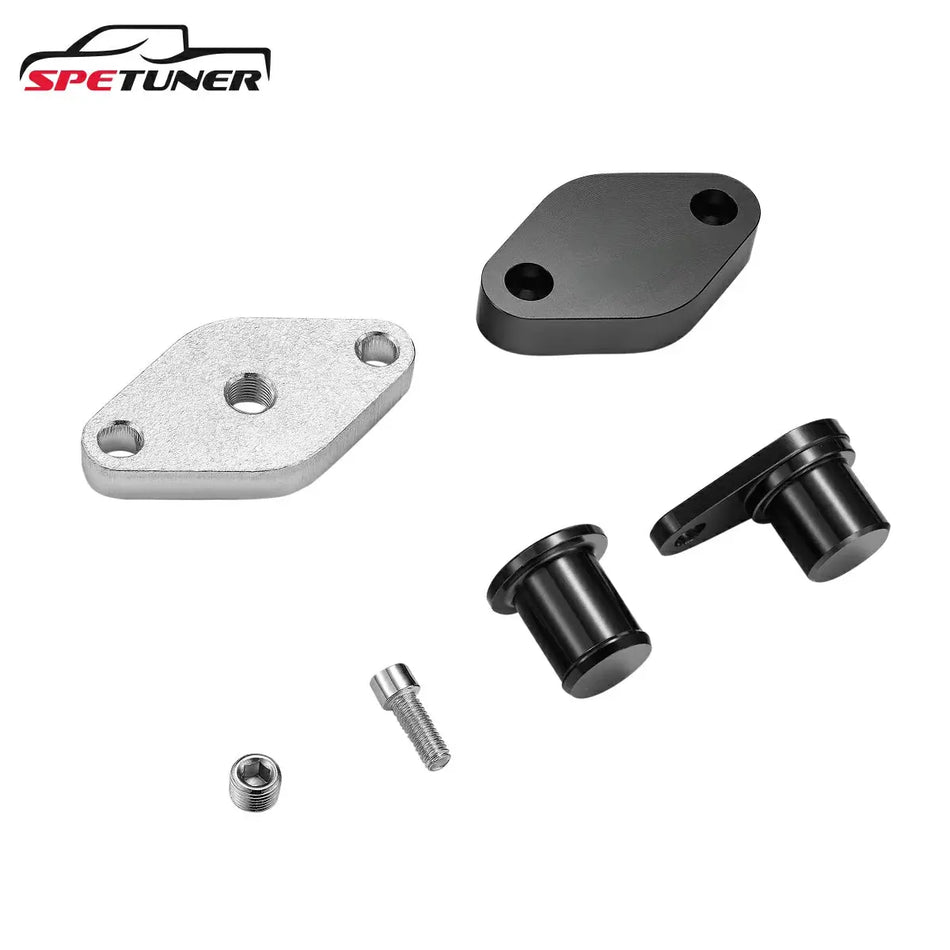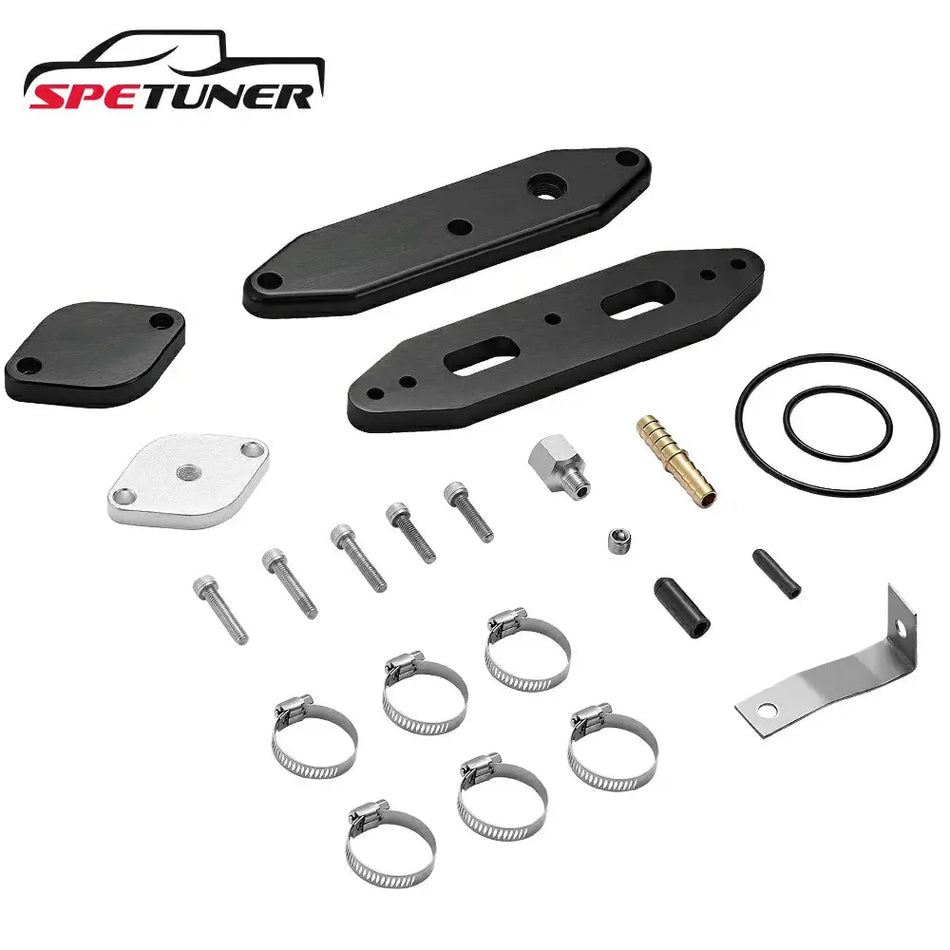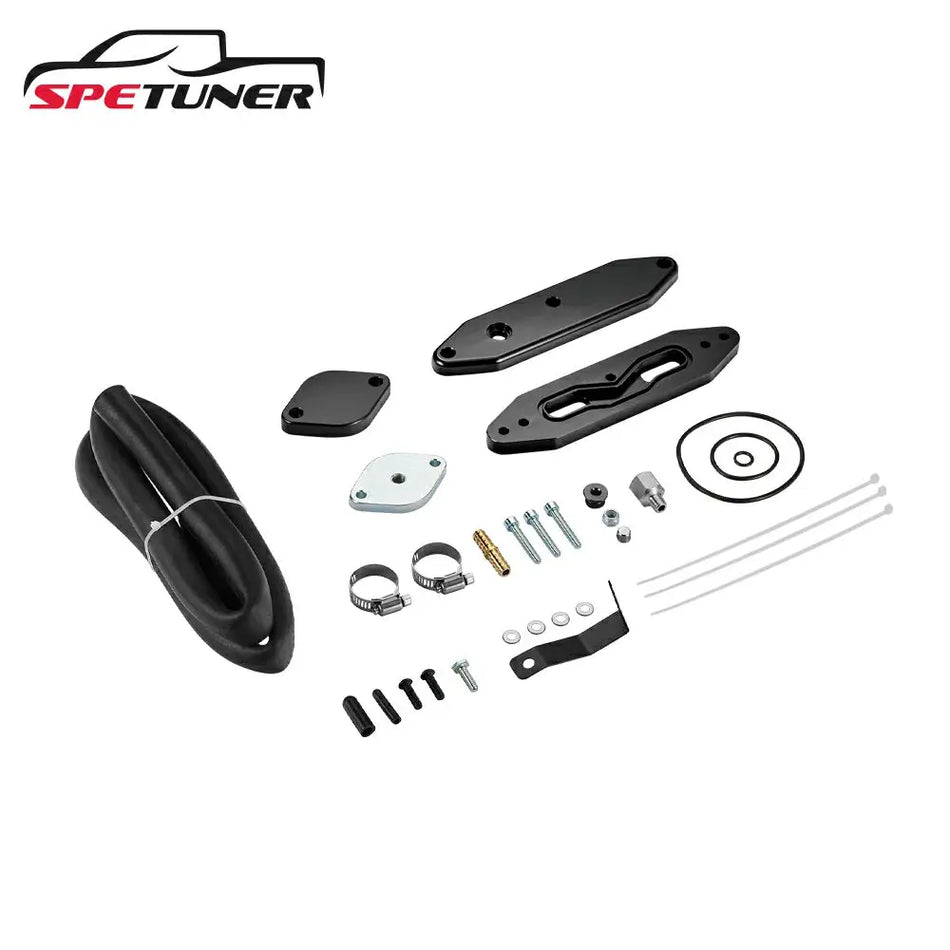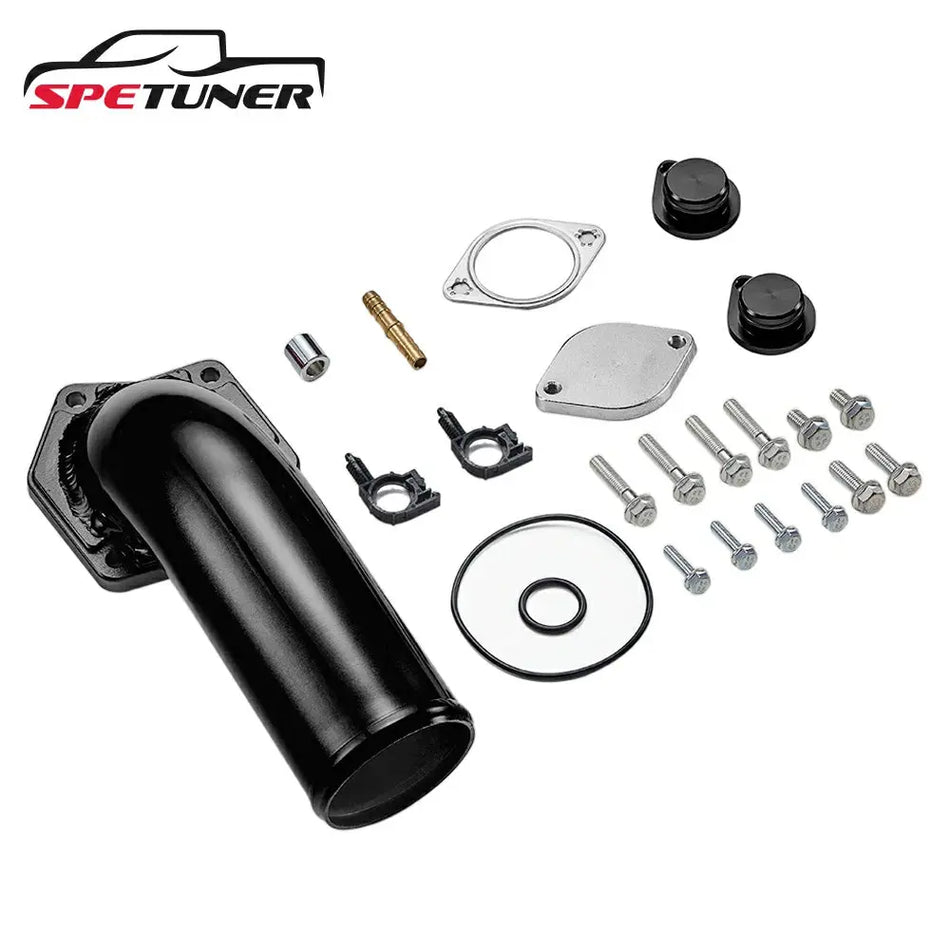Introduction: The Significance and Challenges of EGR Delete
As a 6.7L Cummins owner, you may have experienced issues with engine performance, fuel efficiency, or the high maintenance costs associated with the EGR system. If these issues are familiar, an EGR delete could be a viable solution. The Exhaust Gas Recirculation (EGR) system plays a vital role in reducing nitrogen oxide (NOx) emissions, but it often leads to carbon buildup, reduced engine power, and poor fuel economy.
However, EGR delete modifications can differ significantly based on the model year of your Cummins 6.7L engine. This article will break down the pros and cons of EGR delete based on your vehicle’s model year—2019-2024, 2010-2018, and 2007-2009—so you can make a more informed decision.

1. What is the EGR System? Why Consider Deleting It?
How the EGR System Works
The EGR (Exhaust Gas Recirculation) system works by rerouting a portion of exhaust gases back into the engine’s intake, reducing the formation of nitrogen oxides (NOx). This helps meet emissions standards. However, the process leads to increased carbon deposits, reduced fuel efficiency, and power loss over time, making it a common area for performance upgrades.
Reasons for EGR Deletion
Many owners opt for an EGR delete for the following reasons:
- Power Boost: Deleting the EGR allows for more efficient fuel combustion, leading to improved engine power and throttle response.
- Lower Maintenance Costs: Since the EGR system often leads to carbon buildup and parts failure, removing it can save on repairs and replacements.
- Improved Fuel Economy: More efficient combustion can reduce fuel consumption, especially during long drives or towing.
2. EGR Delete Needs and Challenges for Different Model Years of 6.7L Cummins
2019-2024 6.7L Cummins Owners
For newer 2019 RAM 2500 and 2020 RAM 3500 owners, EGR delete may be more complicated due to stricter emissions regulations. Removing the EGR system could cause the vehicle to fail emissions testing, especially in regions with stringent environmental laws, such as California.
Additionally, the 2019 Cummins EGR Delete may require additional ECU tuning and DEF system adjustments to avoid causing issues with the vehicle’s overall emissions system. Without these modifications, you might experience check engine lights or performance issues.
2010-2018 6.7L Cummins Owners
For owners of 2012 6.7 Cummins or 2015 RAM 3500, the EGR system tends to fail more frequently, especially under heavy loads or towing. Problems like EGR cooler failure or clogging are common, and removing the EGR can result in significant performance gains. Drivers often report improved acceleration and better throttle response after EGR deletion.
2007.5-2009 6.7L Cummins Owners
For owners of 2007 RAM 3500 or 2008 Dodge 6.7 Cummins, EGR systems are relatively older and more prone to issues like carbon buildup. These vehicles tend to have fewer restrictions on emissions regulations, allowing for more freedom to modify the vehicle without immediate legal concerns. EGR deletion in these older models can result in a noticeable increase in power and fuel efficiency.

3. Pros of EGR Delete for 6.7L Cummins
1. Enhanced Engine Performance
When you remove the EGR system on your 6.7L Cummins, the engine no longer recirculates exhaust gases, improving the combustion process's efficiency. This leads to several performance benefits:
- Increased Power: Without the recirculation of exhaust gases, your engine can burn fuel more efficiently, leading to more power at the wheels. Many owners report noticeable improvements in acceleration and overall engine response.
- Better Throttle Response: With no exhaust gases mixing with the fresh intake air, throttle response becomes quicker, making driving feel more engaging and responsive.
For 2019 RAM 2500 or 2012 RAM 3500 owners, an EGR delete can give your engine a performance boost, especially when paired with an EGR delete kit 6.7 Cummins that includes ECU tuning.
2. Improved Fuel Economy
Deleting the EGR system can help your Cummins 6.7L engine run more efficiently. Without the introduction of exhaust gases into the combustion chamber, the engine doesn't have to work as hard to burn fuel, which often results in:
- Reduced Fuel Consumption: Many drivers report improved fuel economy, especially during long-distance drives or when towing heavy loads. The engine uses fuel more effectively, resulting in fewer trips to the gas station.
- More Efficient Power Delivery: The combustion process is more complete, reducing wasted energy and translating to better fuel efficiency, even in demanding conditions.
For example, a 2011 RAM 3500 EGR delete kit can significantly reduce fuel waste in long-haul driving scenarios.
3. Reduced Carbon Buildup
An often overlooked benefit of EGR deletion is the reduction in carbon deposits inside the engine. The EGR system continuously reintroduces exhaust gases back into the engine, leading to carbon buildup over time. These deposits can:
- Clog Engine Components: Affect critical parts like the EGR valve, EGR cooler, and intake system.
- Cause Increased Maintenance Costs: Carbon buildup leads to more frequent maintenance and higher repair costs.
By removing the EGR, you prevent carbon from entering the engine, extending the life of components and reducing maintenance costs.
4. Cons of EGR Delete for 6.7L Cummins
1. Environmental Impact
One of the most significant drawbacks of deleting the EGR system is its impact on the environment. Since EGR deletes prevent exhaust gases from being recirculated into the engine:
- Increased NOx Emissions: NOx gases contribute to air pollution and can cause smog. Without the EGR to lower combustion temperatures, the engine will produce more NOx emissions, which negatively impacts air quality.
- Environmental Regulations: In places with stringent environmental laws like California or under federal regulations in the U.S., removing the EGR system may violate emission standards, leading to possible fines and legal issues. This makes it crucial for owners of vehicles like 2019 RAM 2500 or 2020 Cummins to carefully consider the local laws before making this modification.
2. Legal Concerns
In many regions, the EGR delete is considered illegal because it violates emission regulations. Some areas, such as California, have particularly strict standards set by the California Air Resources Board (CARB), and modifying or deleting emission control systems can lead to:
- Failed Emission Tests: In areas that require smog checks or regular emissions testing, a vehicle with an EGR delete will likely fail.
- Potential Fines: If caught with an illegal modification, owners may face hefty fines or penalties. This is especially true for 2019-2024 6.7L Cummins owners in states with aggressive emissions enforcement.
3. Voiding the Manufacturer’s Warranty
Another con of the EGR delete is that it can void your vehicle’s warranty. Most manufacturers have clear clauses stating that any modification to the emission control system will result in the loss of warranty coverage. For example:
- Engine Warranty Risks: If your 2019 Cummins EGR delete results in engine damage or component failure, you could be left to cover the repair costs yourself, as the manufacturer would no longer be responsible for any defects.
For those looking to keep their warranty intact, an EGR delete kit 6.7 Cummins 2019 might not be the right choice unless you’re prepared to cover potential costs.

5. How to Perform an EGR Delete on a 6.7L Cummins Engine
1. Tools You’ll Need for an EGR Delete
Before diving into the EGR delete process, you’ll need to gather some essential tools and parts. While some steps can be done with basic hand tools, a complete EGR delete kit 6.7 Cummins will make the job significantly easier. Here's a list of what you'll need:
- Wrenches and socket sets: These will be essential for removing the EGR valve, cooler, and other components.
- Screwdrivers: To remove fasteners and connections that hold the system in place.
- Safety Gear: Ensure you have gloves and safety glasses to protect yourself while working under the hood.
- EGR Delete Kit: A high-quality kit, like the best 6.7 Cummins EGR delete kit, which includes all the necessary parts, such as baffles, seals, and a tuner to optimize engine performance.
2. Step-by-Step EGR Delete Process for Different 6.7L Cummins Models
When performing an EGR delete on your 6.7L Cummins engine, it's important to follow the correct procedure based on your vehicle's model year. Different years may have slight variations in components and installation steps.
For precise instructions tailored to your specific truck, visit our SPETUNER CUMMINS Installation Guides. These detailed guides cover various Dodge RAM models, including the 2019 RAM 2500, 2011 RAM 3500, and earlier years like 2012 and 2010. The guides are packed with model-specific tips to ensure a smooth and efficient installation of your EGR delete kit.
Key Model Years:
- 2019-2024 RAM 2500/3500: Tailored instructions for the newer 6.7L Cummins engines with advanced emission systems.
- 2010-2018 RAM 2500/3500: Detailed steps for earlier Cummins EGR delete kits designed for models with slightly different components.
- 2007.5-2009 RAM 2500/3500: Older models with their own unique configuration and installation nuances.
Make sure to check the right guide and refer to the corresponding PDF documentation for your truck's year to avoid any complications during installation.
3. Common Challenges During EGR Delete Installation
While the process is relatively straightforward, there can be a few challenges that might come up during the installation:
- Hard-to-Reach Bolts: The EGR valve and cooler can sometimes be difficult to reach, especially in cramped engine bays.
- Stubborn Components: Some parts of the EGR system may be stuck due to heat or carbon buildup. You may need a bit more force or patience to remove these components.
- Reprogramming the ECU: Some drivers find it tricky to properly tune the ECU without the right equipment. Using a high-quality tuner from a trusted brand like SPETUNER can make this part of the process much easier.

6. Legal and Environmental Considerations of EGR Delete
While an EGR delete on your 6.7L Cummins may offer performance and fuel economy improvements, it's crucial to weigh the legal and environmental implications before proceeding.
Legal Risks and Emissions Regulations
One of the first things to consider when contemplating an EGR delete is the legality of such modifications in your area. In many regions, particularly in the United States, vehicle modifications that alter the emissions control systems are subject to strict regulations.
-
EPA Regulations: The Environmental Protection Agency (EPA) enforces regulations that prohibit modifications to emissions systems, including the EGR system. These regulations apply to all diesel vehicles, including the 6.7L Cummins engines in your Dodge RAM. If you perform an EGR delete, your vehicle could be considered non-compliant with federal emission standards, potentially leading to fines, vehicle impoundment, or failure of an emissions test.
-
State-Specific Rules: Some states, like California, have even stricter laws regarding emissions systems. The California Air Resources Board (CARB) imposes severe penalties for anyone who modifies or deletes emission control components like the EGR system. California, in particular, requires that any modification be certified, meaning EGR delete could be illegal unless you have the proper certifications or use CARB-approved products.
Environmental Impact: The NOx Emission Debate
From an environmental perspective, deleting the EGR system may lead to an increase in NOx (nitrogen oxide) emissions. The EGR system plays a vital role in reducing these harmful emissions, which contribute to air pollution and smog. By deleting the EGR, you may improve engine performance and reduce certain engine stresses, but you'll likely be increasing the overall pollution output from your vehicle.
-
Increased NOx Emissions: With the EGR system deleted, there’s no longer any exhaust gas being recirculated into the engine, which increases the combustion temperatures. Higher temperatures lead to a higher production of NOx emissions, which is harmful to air quality and contributes to environmental degradation.
-
Sustainability Considerations: If you’re environmentally conscious and concerned about the impact of your truck’s emissions, this is a key consideration. Depending on where you live, there may be alternative upgrades or tuning options that can boost performance without sacrificing your commitment to lowering emissions.
Alternatives to EGR Delete
If you want the benefits of performance upgrades without the potential legal or environmental consequences, consider the following alternatives:
-
ECU Tuning: Some tuning software and chips can modify engine parameters to optimize performance without the need for a full EGR delete. These options allow you to improve fuel economy and power while keeping your emissions system intact.
-
EGR Bypass: In some cases, you may be able to reroute or bypass the EGR system without completely removing it. This approach may reduce some of the negative effects of the system while still keeping you within legal limits.
-
CARB-Approved Systems: If you're in a state like California, look for CARB-approved EGR delete kits or performance chips that comply with local emissions standards.
7. Why Choose SPETUNER’s EGR Delete Kit?
When you choose an EGR delete kit for your 6.7L Cummins, quality and reliability should be your top priorities. At SPETUNER, we understand the importance of durable, high-performance components to enhance your vehicle’s efficiency and power. Here's why our EGR delete kit is the perfect choice for your 6.7L Cummins truck:
High Quality and High Performance
As a trusted manufacturer of automotive performance parts, SPETUNER is committed to providing high-quality, high-performance products. Each of our EGR delete kits undergoes strict quality control and testing to ensure long-lasting, stable operation.
-
Premium Materials: We use only the finest materials to manufacture the essential components of the kit, including baffles, seals, and tuners. These parts are engineered for durability, with the seals offering superior tightness to prevent leaks, and the baffles ensuring maximum exhaust flow efficiency.
-
Optimized Engine Performance: The advanced tuner in our kit leverages cutting-edge technology to optimize your engine control unit (ECU). This improves your engine’s performance, resulting in smoother operation, enhanced power, and better fuel economy—whether you're driving a 2019 RAM 2500 or a 2012 RAM 3500.
Excellent Service
At SPETUNER, we pride ourselves not only on the quality of our products but also on the exceptional customer service we provide. Our service is global, covering regions such as North America, South America, Asia, the Middle East, and Europe.
-
Fast and Reliable Shipping: With our warehouses strategically located in Kentucky, California, and New Jersey, we ensure timely deliveries, no matter where you're located.
-
Customer Support: Our team is always available to offer support and assistance, ensuring that your experience is smooth and hassle-free. Whether you need help with installation or have a question about the product, we are here to help.
Customer Satisfaction
We believe that customer satisfaction is the key to our success. That’s why we prioritize your needs and strive to exceed your expectations. SPETUNER’s business philosophy revolves around delivering high-quality, high-performance, and customer-centric solutions.
-
Comprehensive Support: If you have any questions or concerns about our EGR delete kit or installation, we’re here to assist you every step of the way.
-
Customer-Centered Approach: We value every customer and are dedicated to ensuring your satisfaction. If you’re not fully satisfied with your purchase, don’t hesitate to contact us for assistance. We will work diligently to resolve any issues.
Choose SPETUNER for High-Quality Performance Parts
By choosing SPETUNER, you're selecting not just high-quality performance parts, but also the reliability and support you need to take your 6.7L Cummins to the next level. Our EGR delete kits are designed with performance, durability, and ease of installation in mind—backed by exceptional service to enhance your overall experience.
Conclusion
Ready to boost your truck’s performance? Explore our high-quality EGR delete kits today and experience the difference firsthand. Whether you own a 2019 RAM 2500 or a 2012 Cummins, we have the right solution.
FAQs
Q1: What is a 6.7 Cummins EGR delete kit?
A1: A 6.7 Cummins EGR delete kit removes the Exhaust Gas Recirculation (EGR) system, which improves engine performance, efficiency, and reduces carbon buildup.
Q2: Why should I consider installing an EGR delete kit on my 6.7 Cummins?
A2: It enhances engine performance, fuel economy, and reduces maintenance costs by eliminating carbon buildup caused by the EGR system.
Q3: Will an EGR delete kit increase the power of my 6.7 Cummins engine?
A3: Yes, removing the EGR system leads to more efficient combustion, resulting in better power output and quicker throttle response.
Q4: Can an EGR delete improve fuel efficiency in my 6.7 Cummins?
A4: Many users report improved fuel efficiency after performing an EGR delete due to better combustion and reduced engine strain.
Q5: Is an EGR delete legal in my area?
A5: EGR delete may be illegal in some states or regions due to emission laws. Check your local regulations before installation.
Q6: Will deleting the EGR system affect my 6.7 Cummins' warranty?
A6: Yes, performing an EGR delete may void the warranty as it alters the emissions system. Always check with your manufacturer.
Q7: How long does it take to install an EGR delete kit on a 6.7 Cummins?
A7: Installation time varies, but typically it takes 2 to 4 hours for most truck owners to install the kit.
Q8: Does installing an EGR delete kit require additional tuning?
A8: Yes, you'll need to use a tuner to adjust the engine's ECU settings for optimal performance after the EGR delete.
Q9: Will deleting the EGR system damage my 6.7 Cummins engine?
A9: No, when done correctly with the right kit and proper tuning, an EGR delete won't damage your engine; it can actually improve its longevity.
Q10: Can I reverse the EGR delete if I change my mind later?
A10: Yes, but it may require reinstallation of the original EGR components and a re-tuning of the ECU. It's best to consult a professional.











